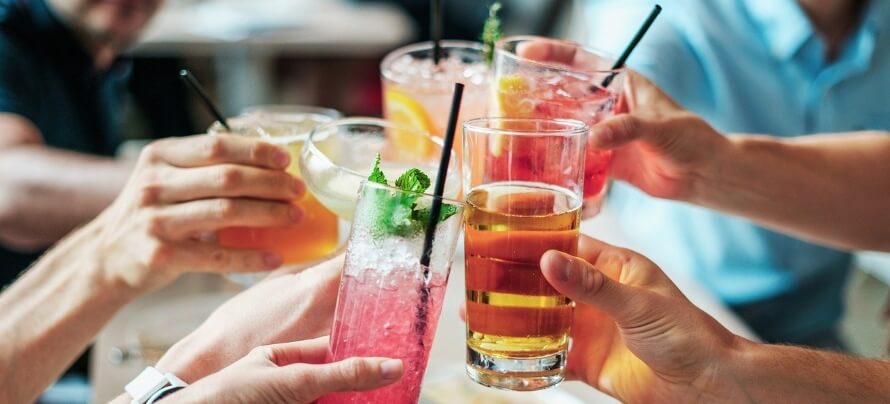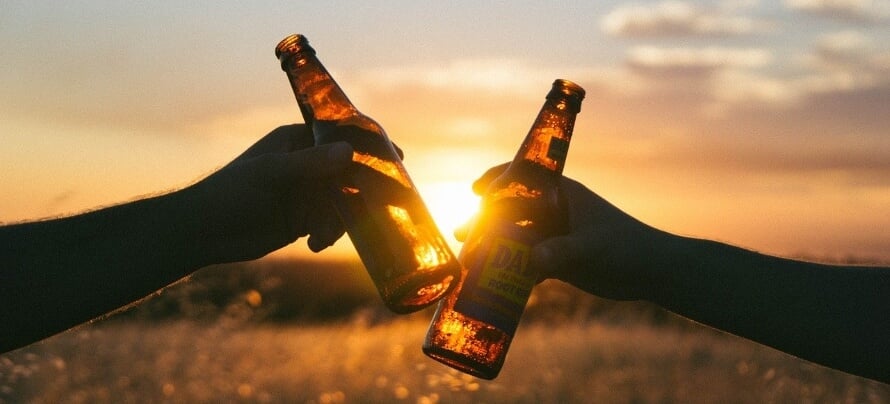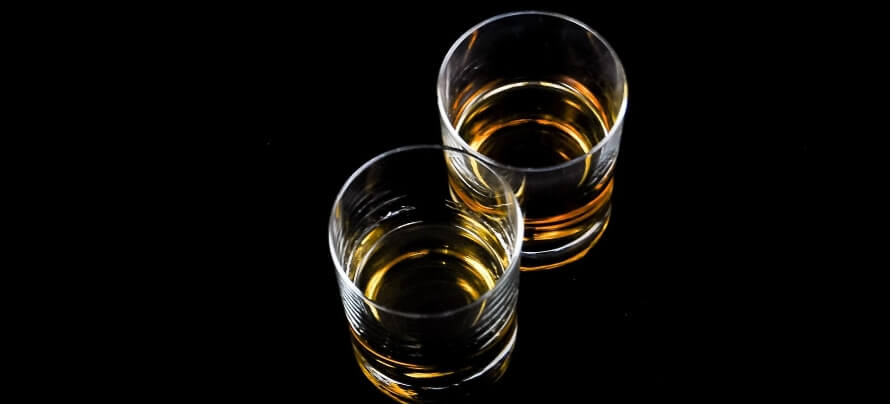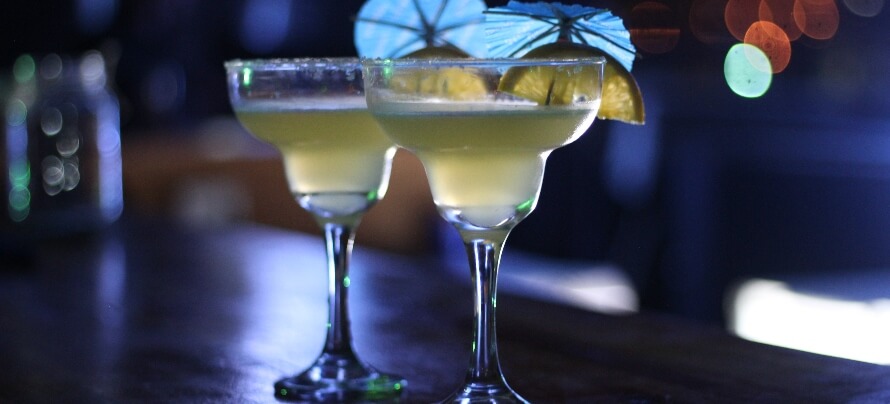Key Takeaways
- Alcoholic drinks contain calories in the form of ethanol, which contains 7 calories per gram.
- Alcoholic drinks vary in their calorie content, but most standard beers contain 150 calories per serving, most wines are around 130 calories per glass, and most liquors are around 100 calories per shot.
- Many alcoholic drinks can contain far more (or fewer) calories than this, especially when mixed with other drinks or flavorings. Keep reading to learn which drinks have the most or fewest calories!
Alcoholic drinks get a bad rap in the fitness community.
Many people believe alcohol is uniquely fattening, and that they need to give it up entirely if they want to lose fat.
While there are plenty of reasons to limit your alcohol intake, staying lean isn’t actually a great one.
You see, the calories from alcohol aren’t any more inherently fattening than the ones found in other foods like broccoli, brownies, chicken breast, or chocolate.
Alcohol can contribute to weight gain in the same manner as any other food, though—by contributing to a calorie surplus.
Alcohol is relatively high in calories, and alcoholic drinks often have other high-calorie beverages like juice mixed in.
Thus, if you want to enjoy alcohol while staying lean, it pays to know how many calories are in your favorite alcoholic beverages.
In this article, you’re going to learn all about alcoholic drinks, how many calories they contain, and which drinks are the smartest choices if you want to keep your calories low.
Table of Contents
+
What Is Alcohol?

Alcohol, technically known as ethyl alcohol or ethanol is a compound produced when yeast bacteria ferment sugars.
Alcohol is a depressant, which is the opposite of a stimulant. In general, this means it makes you more relaxed and less anxious, lowers inhibitions, and can make you more sociable. Larger doses of ethanol can cause drunkenness, which often involves impaired coordination, slurred speech, and reduced cognitive abilities.
Alcoholic beverages are one of the most common recreational drugs, served at parties, celebrations, and dinners.
Since alcohol plays such a significant role in social activities, health-conscious individuals often want to know how many calories they’re imbibing at happy hour, holiday parties, and the like.
Well, ethanol contains about 7 calories per gram, making it more calorie-dense than carbs and protein (4 calories per gram), but slightly less than fat (9 calories per gram). However, most alcoholic beverages contain more than ethanol. That’s one reason why their calorie counts differ, which we’ll get into more later.
Although many people think alcohol is uniquely fattening, the opposite is actually true.
Ethanol, the calorie-containing portion of alcohol, is never directly converted into body fat. In other words, ethanol can’t produce fat gain in the same way as calories from other foods can.
However, alcohol blunts fat oxidation and triggers de novo lipogenesis (DNL), the process by which excess carbs are converted into fatty acids. In this way, alcoholic drinks can contribute to fat gain by increasing the proportion of dietary fat and carbs that is converted into body fat.
If you want to know more about whether alcohol can halt fat loss or limit muscle growth, read this article:
Does Alcohol Consumption Affect Weight Loss and Muscle Growth?
Summary: Alcohol is a compound produced through fermentation that contains 7 calories per gram, and although it’s not stored directly as body fat, it can increase fat gain by causing more dietary fat and carbs to be stored as body fat.
How Many Calories Are in Alcoholic Drinks?
Before we can talk about the amount of calories in alcoholic beverages, you need to understand that there any many different types of alcoholic drinks.
There are fermented beverages like wine and beer, distilled spirits like vodka and whiskey, and mixed drinks, which contain alcohol and other ingredients.
Fermented beverages contain alcohol as well as traces of whatever was used to trigger fermentation (like grapes for wine or barley for beer).
Spirits, on the other hand, are distilled, which means the alcohol is extracted during the fermentation process.
Calories can differ quite a bit based on what you’re drinking, how much you’re drinking, and the exact proportions used in your mixed beverage recipes.
In fact, most of the calories in mixed drinks come from additional ingredients like sugar, not the alcohol itself.
Let’s cover some of the most popular alcoholic drinks.
Summary: There are different types of alcoholic beverages, including fermented drinks, distilled spirits, and mixed drinks, which will all differ in their calorie content based on how the alcohol is produced and what ingredients it’s mixed with.
How Many Calories Are in Beer?

Beer is a beverage made from fermented grains (often malted barley) and flavored with hops, a flower that adds a bitter fruitiness.
Since beer is a fermented drink (not distilled or purified like liquor), it contains not only alcohol, but carbs from the grains used during fermentation.
Because beer is the most popular alcoholic drink in the world, it’s no surprise there’s an astounding number of types and variations available. Naturally, their nutrition content varies quite a bit.
Most beers are around 5% alcohol by volume (ABV), but they can range from non-alcoholic to 14% or even higher.
Beers with a higher ABV and more carbs are going to contain more calories.
A typical can of beer is 12 fluid ounces, so we’ll consider that one serving for our purposes here.
Most standard beers like Budweiser, Corona Extra, and Heineken are about 150 calories per serving with 10 to 15 grams of carbs and 5% ABV.
A “richer” beer like Sam Adams Boston Lager is also 5%, but contains more carbs, clocking in at 175 calories per serving.
Light beers like Miller Lite, Bud Light, and Coors Light are about 100 calories per serving with fewer carbs and 4% ABV.
Summary: A 12-ounce serving of most kinds of beer will be about 150 calories, although some beers can contain as little as 100 calories and others contain almost 200 calories.
How Many Calories Are in Wine?
Wine is a fermented beverage made from grapes. It can be made with different types of grapes that are processed differently, aged, or blended to create different flavors.
Most wines are around 14% ABV, but they can range from 7% to more than 16%.
A typical serving of wine is 5 fluid ounces. Most wines are around 120 to 130 calories per serving, but they can vary based on alcohol and carb content.
For example, sweeter dessert wines such as Vin de Paille usually contain more sugar and thus, more calories.
Generally, red wines such as Cabernet Sauvignon contain slightly more calories than white wines, but it really depends on alcohol and carb content of the specific wine.
To reduce calorie content in wine, pick a variety that’s dry (which means it’s not sweet). You can also consider adding sparkling water to your wine for an interesting twist that gives you a larger drink without more calories.
Summary: A typical 5 ounce glass of 14% ABV wine is around 120 to 130 calories per serving, but the calories in wine can vary from about 100 calories per serving to 150 calories per serving based on the alcohol and carb content.
How Many Calories Are in Vodka?
Vodka is a clear liquor made from distilling fermented grains, potatoes, or sometimes sugar beets, and then filtering the liquid that’s left over. It’s then usually diluted with water until the liquid becomes 40% ABV.
Vodka can be drunk “neat” (without mixers or added flavorings), but it’s often used as a base in many mixed drinks and cocktails such as Screwdrivers, Cosmopolitans, and White Russians.
A 1.5 ounce shot of vodka is about 100 calories.
How Many Calories Are in Tequila?
Tequila is a type of liquor made from blue agave, a plant found in Mexico.
Piñas (cores) are manually harvested from the agave plant, cooked, and shredded before being juiced into tanks for fermenting.
The fermented juice is then distilled multiple times, resulting in a 40% ABV tequila that’s either bottled or aged in wooden casks.
Tequila serves as a nice canvas for many mixed drinks, including the Margarita and Tequila Sunrise.
Like other 40% distilled spirits, a 1.5 ounce shot of pure tequila is around 100 calories.
How Many Calories Are in Whiskey?

Whiskey is a smoky-flavored liquor made from fermented grains, including barley, wheat, and rye. There are many different types of whiskey, depending on how those grains are processed and where the whiskey is made.
For example, Scotch is whiskey made in Scotland typically from malted barley and aged for at least 3 years.
Bourbon is a specific type of American whiskey made mostly from corn and aged in charred oak barrels.
Most whiskeys are 40% ABV and a 1.5 ounce shot of the “liquid gold” contains 100 calories.
How Many Calories Are in Gin?
Gin is a liquor typically made from fermented grains like barley and flavored with juniper berries.
A 1.5 fluid ounce shot of 90 proof gin (45% ABV) contains about 110 calories.
Gin is often mixed with tonic water (gin and tonic), which is a bitter, carbonated water with quinine and is usually sweetened. Twelve fluid ounces of tonic is about 130 calories.
Gin to tonic ratios can vary, but assuming you’re getting a 1:1 ratio, a 4-ounce gin and tonic would contain 170 calories.
How Many Calories Are in Rum?
Rum is a type of liquor made from fermented sugarcane molasses or juice. It’s then distilled and aged in wooden or stainless steel barrels.
Flavored or spiced rums could contain additional calories depending on what ingredients are added.
White rum generally has less flavor than dark rum, which is aged in barrels for longer.
Most rum is 40% ABV and a 1.5 ounce shot is roughly 100 calories.
How Many Calories Are in Cognac?
Cognac is a specific type of brandy produced in the Cognac region of France. It’s made by distilling white wine and aging it in oak barrels for at least two years for some extra flavor.
Cognac is 40% ABV and a 1.5 ounce shot of cognac is about 100 calories like other similar spirits.
How Many Calories Are in an Old Fashioned?
The Old Fashioned is one of the most well-known cocktails. It’s fairly simple to make too.
The standard recipe is 1.5 ounces of bourbon or whiskey, a couple dashes of Angostura bitters, and a sugar cube.
Eighty proof bourbon (40% ABV) clocks in at about 100 calories for 1.5 ounces and the sugar adds 10 to 15 calories.
The bitters are normally alcoholic, but 2 dashes add a negligible amount of calories.
Altogether, you’re looking at about 115 calories for a standard Old Fashioned. Larger pours, higher proof whiskey, and garnishes will add more.
How Many Calories Are in a Piña Colada?
A piña colada is a mixed drink made with white rum, pineapple juice, and coconut milk.
A typical recipe would be 1-ounce of rum, 1-ounce of coconut milk, and 3-ounces of pineapple juice, blended with ice.
Given that recipe in those amounts, there are 65 calories in the coconut milk, 65 calories in the rum, and 45 calories in the pineapple juice.
Add in a maraschino cherry and slice of pineapple as garnishes and you’re looking at 215 delightfully tropical calories.
How Many Calories Are in a Whiskey Sour?
A whiskey sour is made with 3 parts bourbon, 2 parts lemon juice, and 1 part simple syrup.
Given 1.5 ounces of bourbon (100 calories), 1 ounce of lemon juice (7 calories), and 0.5 ounces of simple syrup (45 calories), you’re looking at just over 150 calories.
That’s a fairly small drink, so keep in mind a larger whiskey sour will have more calories.
So, all in all a typical whiskey sour will likely have around 150 to 200 calories.
How Many Calories Are in a Martini?

A classic martini is made with 3 ounces of gin and 0.5 ounces of dry vermouth and garnished with a green olive.
Dry vermouth is a fortified wine (basically wine with brandy added to make it more alcoholic) that’s flavored with herbs and spices.
The dry vermouth adds about 18 calories to the 200 coming from gin and a green olive adds a paltry 4 calories.
Altogether, a 3.5-ounce martini contains about 220 calories.
How Many Calories Are in a Long Island Iced Tea?
The Long Island Iced Tea is a popular mixed beverage with countless variations. The International Bartenders Association-approved recipe includes 5 equal parts of tequila, vodka, white rum, triple sec (an orange-flavored liqueur), and gin (0.5-ounces each).
You then add lemon juice, 1 ounce of Gomme syrup (basically simple syrup), and a dash of cola.
In terms of calories, you can expect about 130 for the 4 liquors, 30 to 60 calories for the triple sec (depending on the ABV and sugar content), 90 calories for the Gomme syrup, and another 5 for the lemon juice.
Altogether, a standard Long Island Iced Tea is around 275 calories.
How Many Calories Are in a Dark ‘N’ Stormy?
A Dark ‘N’ Stormy is a simple beverage made with 2-ounces of dark rum and a little over 3-ounces of ginger beer.
Despite its name, ginger beer is more like ginger ale, in the sense that it’s typically a non-alcoholic soft drink with sugar and carbonation.
Mix it with dark rum in the specified amounts and you’ll be imbibing a bubbling 185 calories or so.
A typical Dark ‘N’ Stormy contains 185 calories, although you can reduce this amount by using diet ginger beer.
What Alcoholic Drinks Have the Least Calories?
If you want to drink alcohol, you’re going to be consuming some calories. There’s just no way around it.
However, if you want to minimize your beverage calories, pick drinks with fewer carbs, less alcohol, and fewer mixers.
Or you can use zero-calorie additions like diet drinks or soda water, which is just carbonated H2O. It’s also called club soda, seltzer, or sparkling water.
For example, a shot of rum will be fewer calories than a pint of beer. And a glass of wine will be fewer calories than a tall glass of sugar-laden rum and coke.
But if you really want a rum and coke, try rum with diet cola to save some calories.
One of the problems with alcohol is it can really mess up a cheat meal.
Cheat meals are planned meals where you eat more calories than usual, or where you eat foods you wouldn’t normally include as part of your meal plan.
Consuming alcohol lowers your inhibitions, which often means you’ll give in to food cravings, eat more, and maybe even binge.
You learned earlier that alcohol reduces fat oxidation and triggers DNL, and when you mix this double whammy with overeating—especially the greasy, fatty foods most people like to eat when drinking—you get maximum fat gain.
Just one or two large alcohol-infused cheat meals per week can be enough to wipe out all of the fat you’ve lost the rest of the time.
Therefore, if you want to drink alcohol without interfering with your fat loss or accelerating fat gain, follow these three tips:
- Don’t drink more than one day per week.
- Lower your carb and fat intakes that day. (Eat more protein than you normally would.)
- Try not to eat while drinking and stay away from carb-filled drinks like beer
and sweet, fruity stuff. (Stick to dry wines and spirits.)
Summary: Pure liquors contain fewer calories than wine and beer, but mixed drinks often contain the most calories when they feature sweet mixers. Avoid drinking too often and don’t eat a bunch of greasy food if you’re going to have a couple of drinks.
The Bottom Line on Calories in Alcohol
Alcohol contains 7 calories per gram, more than carbs and protein but less than fat.
Although alcohol is never stored directly as body fat, it does shut down fat burning and increases the storage of dietary fat and carbs as body fat.
There are different types of alcoholic beverages, including fermented drinks, distilled liquors, and mixed drinks, which will all differ in their calorie content based on how much alcohol they contain, how the beverage is processed and what ingredients are added.
For example, a typical 12-ounce serving of 5% ABV beer contains about 150 calories.
A standard 5-ounce glass of 14% ABV wine is around 120 to 130 calories per serving, but they can vary based on sweetness and carb content.
Liquors that are distilled into 40% ABV spirits are about 100 calories per 1.5 ounce shot.
Mixed drinks can vary considerably depending on the mixers added and size of the beverage.
If you’re going to drink, but want the fewest calories possible, go with spirits like vodka, whiskey, or rum. Pure liquors contain fewer calories than wine and beer, but mixed drinks often contain the most calories since they’re usually mixed with sweet additions.
And if you’re going to have a couple drinks, avoid eating a bunch of greasy food at the same time.
The most important thing is to simply not drink that often, and try to keep your portions reasonable. If you’re intent on drinking a lot, then make sure you don’t do this very often.
What do you think of alcoholic drinks? Have anything else to add? Lemme know in the comments below!
Scientific References +
- You M, Arteel GE. Effect of ethanol on lipid metabolism. J Hepatol. 2019;70(2):237-248. doi:10.1016/j.jhep.2018.10.037
- Shelmet JJ, Reichard GA, Skutches CL, Hoeldtke RD, Owen OE, Boden G. Ethanol causes acute inhibition of carbohydrate, fat, and protein oxidation and insulin resistance. J Clin Invest. 1988;81(4). doi:10.1172/JCI113428
- Siler SQ, Neese RA, Hellerstein MK. De novo lipogenesis, lipid kinetics, and whole-body lipid balances in humans after acute alcohol consumption. Am J Clin Nutr. 1999;70(5):928-936. doi:10.1093/ajcn/70.5.928
- Composition of Foods Raw, Processed, Prepared USDA National Nutrient Database for Standard Reference, Release 26 Documentation and User Guide.; 2013.










